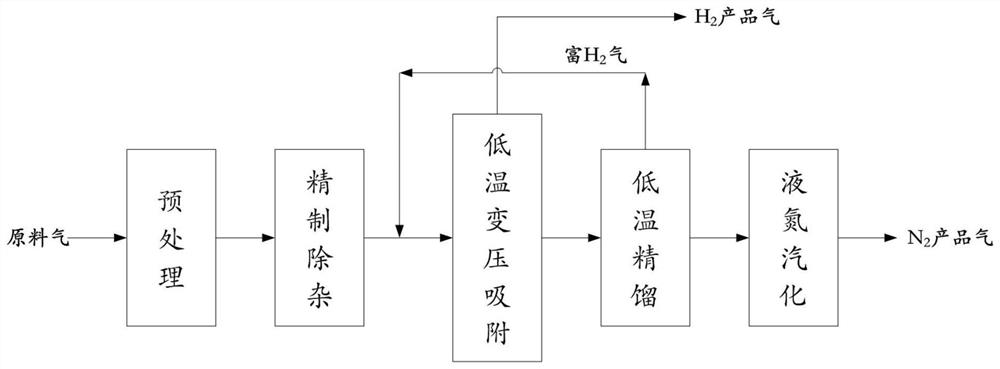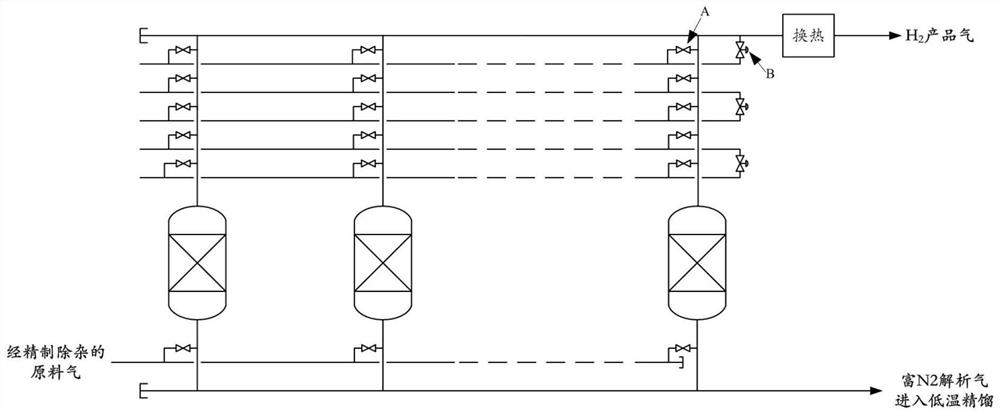A method for separation, purification and reuse of mixed tail gas of hydrogen and nitrogen in MOCVD process
A hydrogen-nitrogen and tail gas technology, applied in hydrogen separation, nitrogen purification/separation, solid contact hydrogen separation, etc., can solve the problems of inability to truly realize the recycling of electronic-grade nitrogen and hydrogen resources, the purity is not up to standard, and high energy consumption. Improve the recovery rate, realize the effect of zero emission of tail gas and low energy consumption
- Summary
- Abstract
- Description
- Claims
- Application Information
AI Technical Summary
Problems solved by technology
Method used
Image
Examples
Embodiment 1
[0041] Such as figure 1 As shown, a method of low-temperature adsorption and rectification coupling separation, purification and reuse of hydrogen and nitrogen tail gas in the MOCVD process, the specific implementation steps include:
[0042] (1) Raw material gas, that is, normal or low pressure MOCVD (metal oxide chemical vapor deposition) to prepare exhaust gas in the process of light-emitting diode (LED) based on gallium nitride (GaN) epitaxial wafer growth, after deamination including dust removal, oil removal and deamination The hydrogen-nitrogen mixture obtained after pretreatment including drying and fine filtration, the flow rate is 1,000 standard cubic meters per hour, and its main composition is nitrogen (N 2 ): 56.4% (v / v, the following are similar), hydrogen (H 2 ): 43.4%, ammonia (NH 3 ): 0.2% and other traces of volatile organic compounds (VOCs), methane (CH 4 ), water (H 2 O), carbon monoxide (CO), carbon dioxide (CO 2 ), oxygen (O 2 ) and other impurity c...
Embodiment 2
[0047] Such as figure 2 As shown, on the basis of Example 1, the impurity component content of ammonia and volatile organic compounds (VOCs, metal-organic compounds) in the raw gas is greater than 1 to 3% (volume ratio), that is, due to the water elution in the pretreatment When nitrogen and VOCs removal effects are poor and fluctuate, it is necessary to add a first-stage molecular sieve permeable membrane before the temperature swing adsorption refined molecular sieve dehydration in the refining and impurity removal step, so that the raw material gas entering the low temperature pressure swing adsorption process includes ammonia, VOCs and The content of water impurity components is reduced to below 0.1ppm to ensure the normal operation of subsequent low-temperature adsorption and low-temperature rectification separation systems.
Embodiment 3
[0049] Such as image 3 As shown, on the basis of Embodiment 1, in the described low temperature pressure swing adsorption (LPSA), the switching degree and the switching time of the regulating valve and the program control valve provided on the pipeline connected between the inlet and outlet of the adsorption tower are adjusted through time sequence , to control the pressure change (pressure equalization) in the LPSA operation to be carried out smoothly and evenly. The number of pressure equalizations in this embodiment is 2 times. The valve opening degree and switching time are determined by the timing design, so as to achieve slow equalization, and prevent the flow rate or fluid pressure in the pipeline from changing too much, resulting in unstable pressure equalization, which will cause a large erosion of the system including the adsorbent and the valve. Wear and tear, and in the early stage of reverse gas discharge, vent a little desorbed gas to ensure that the H flowing o...
PUM
 Login to View More
Login to View More Abstract
Description
Claims
Application Information
 Login to View More
Login to View More - R&D
- Intellectual Property
- Life Sciences
- Materials
- Tech Scout
- Unparalleled Data Quality
- Higher Quality Content
- 60% Fewer Hallucinations
Browse by: Latest US Patents, China's latest patents, Technical Efficacy Thesaurus, Application Domain, Technology Topic, Popular Technical Reports.
© 2025 PatSnap. All rights reserved.Legal|Privacy policy|Modern Slavery Act Transparency Statement|Sitemap|About US| Contact US: help@patsnap.com



